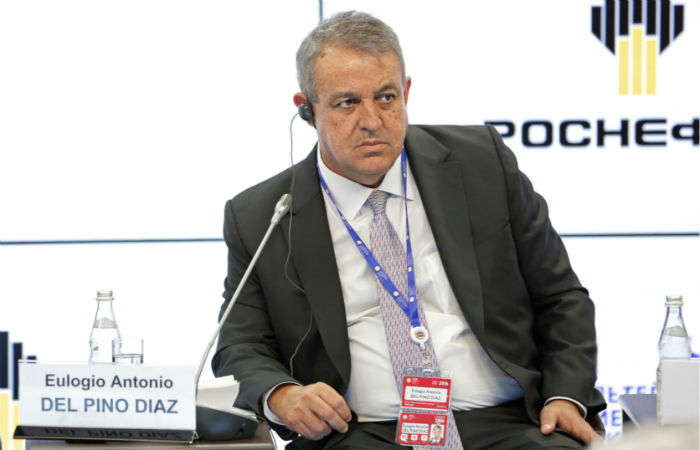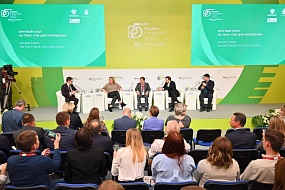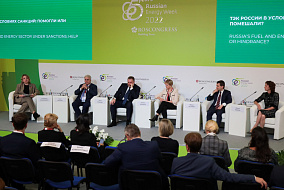The Russian Fuel and Energy Sector in a Time of Transition

KEY CONCLUSIONS
Solar and wind power will be in demand in the near future; however, other renewable energy sources are needed as well
“The engineering and technical sector is growing. The energy mix will evolve. New energy sources will appear, and there will be new breakthroughs in technology,” Pavel Sorokin, Deputy Minister of Energy of the Russian Federation.
“Solar power and wind power do not represent the end of how we think about technological development. They will be part of the energy mix, but I think that we will see new technology appearing in the near future which will offer additional sources of energy,” Sergey Kudryashov, Director General, Zarubezhneft.
Synergy and a balance of various forms of fuel are needed for the development of the energy sector and the energy transition
“We are also looking at issues to do with synergy. For example, there are remote projects in the Nenets Autonomous Area which operate in complete isolation from the energy system. And, we are looking into whether it would be more beneficial to us at specific stages of the life cycle to not only place the emphasis on gas when it comes to the energy production mix. At a particular moment, it will be necessary to move over to diesel, for example. We have been looking into developing wind energy, and we have already begun initial trials. Basically, we are looking at alternative energy specifically in terms of synergy with our main line of business,” Sergey Kudryashov, Director General, Zarubezhneft.
“Up to 2050, hydrocarbons will naturally continue to account for a significant proportion of the overall global energy mix. If we avoid going to extreme ends of the spectrum in terms of either green or traditional forms of energy, we can see that the problem needs to be addressed specifically by focusing on the result. If the result is a reduction in emissions, rather than rebuilding the foundations we currently have, then synergy between the traditional and new segments is the correct path to take,” Pavel Sorokin, Deputy Minister of Energy of the Russian Federation.
“In order for new technology to be developed, implemented, and made more powerful, a balance needs to be struck, particularly in this period of transition. It appears that everything currently happening in the EU is not so much a crisis – so to speak – of alternative energy sources. Rather, it is about certain difficulties, and even, if I may say, mistakes that were made at the stage of planning for the energy transition,” Tatiana Zavyalova, Senior Vice President for ESG (Environmental, Social, and Corporate Governance), Sberbank.
Russia has the potential to develop its gas and hydrogen power sectors
“We believe that even according to the most extreme forecasts we have seen, the share of hydrocarbons in the global energy mix may fall from the 85% it is at currently to perhaps 65%. The extreme scenario puts it at 60–65%, with the baseline scenario somewhere up to 70%. So, there is a baseline load regardless,” Pavel Sorokin, Deputy Minister of Energy of the Russian Federation.
“We have excellent prerequisites in place. Our gas generation production is currently at 47%. We have a major share – 38% if I am not mistaken – of production coming from nuclear and hydro energy. This is an excellent share, which will ensure we have a stable and high-quality economy during this period – a period of transition,” Tatiana Zavyalova, Senior Vice President for ESG (Environmental, Social, and Corporate Governance), Sberbank.
“I know that Russia has substantial potential to develop its hydrogen industry. By 2030, 20% of it could be produced in Russia, and supplied to global and Asian markets. There is a large resource base. We can expect development in this area, and Russia’s growth will have a significant impact on the industry across the globe,” Tore Morten Loeseth, Senior Vice President for International Exploration and Production, Country Manager for Russia, Equinor.
PROBLEMS
Investment in oil and gas has declined significantly in recent years
“Of course, we see what is happening today – since 2014, investment in oil and gas upstream operations has virtually halved. Naturally, this has implications for the future. Secondly, it’s essential to understand that conversely, investment in wind and solar has already exceeded that of upstream operations,” Sergey Kudryashov, Director General, Zarubezhneft.
“The global community is halting investment in traditional segments. And you can see the result – a very rapid leap in fuel prices. Yes, in all likelihood, the situation will rectify itself next year. Nevertheless, this is a big danger sign. That’s because it is not the result of last year’s pandemic – that was simply a catalyst. Investment, however, as has already been said, has fallen over the past 5–7 years,” Pavel Sorokin, Deputy Minister of Energy of the Russian Federation.
SOLUTIONS
An environment needs to be created (including through regulation) to foster a gradual increase in the share of renewable energy
“It’s vital to understand that the world is currently engaged in developing regulation which will direct a large amount of investment specifically to alternative energy. Right now, banks are dealing with aspects related to loans. We will probably even hear today about what they have been doing in this area,” Sergey Kudryashov, Director General, Zarubezhneft.
“Later on, we will of course have to take decisions and achieve the right balance between investment amounts and hitting carbon-related targets, while gradually introducing renewable energy sources and increasing their share. However, it is absolutely clear that our base – gas – will remain regardless,” Tatiana Zavyalova, Senior Vice President for ESG (Environmental, Social, and Corporate Governance), Sberbank.
For more information, visit the Roscongress Foundation’s Information and Analytical System at roscongress.org/en.





